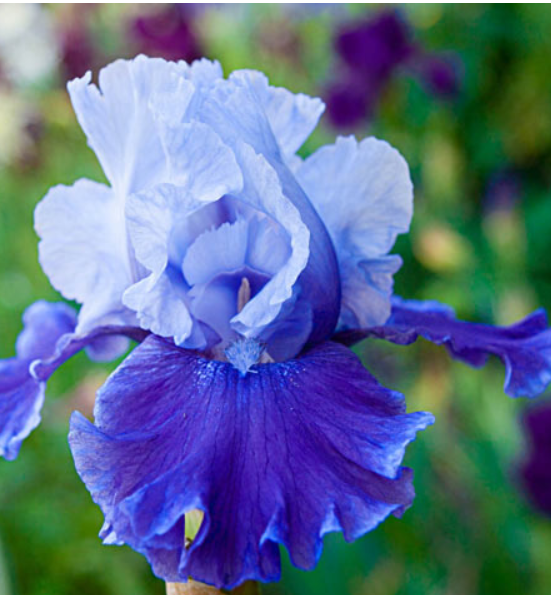Iris In Perfumery
Iris germanica and Iris pallida are both used in quality perfumery and as a scent fixative in true Potpourri. Since the Egyptians the alluring scent has been part of perfumery and skin care. The Chinese scented rice with it. Indeed, Orris root, its official name, is derived from the iris rhizome and has been used for 1,000’s of years.

Iris pallida is grown in Italy and Iris germanica, the hardier of the two species, is grown in Morocco. Orris root is manually harvested, peeled, chopped and then dried for up to 6 years in exacting conditions. The delicate, violet-like-earthy scent takes this time to mature. From this point the perfumers will extract the scent from the dried Orris root for their perfumes. For Potpourri the dried root is left chopped or ground to a powder and used to ‘fix’ the scent of the flowers in your recipe.
Iris In the Garden
Iris germanica pumila hybrids are reliable, drought tolerant perennials suited to full sun in soil with good drainage. All are under 3 feet tall, and hardier than their taller relations.
Called Bearded Iris as there is a raised fuzzy strip that looks like a beard, on the three petals that fall or curve down. The three petals that stand upright are called standards. Dwarf German Iris are typically early summer bloomers and come in a rainbow of colours from deep, velvety purple to chiffon-like peach. The attractive, green, spear like foliage is sturdy and fan shaped. Utilize the foliage as a back drop for later blooming and mounding perennials such as Lady’s Mantle and or Bevan’s Scented or Ballerina geraniums.
Iris pallida or Sweet Iris has variegated foliage in cream or white and gray-green, this Iris prefers a moist site in full sun or part shade. Similarly, it blooms in late spring or early summer. Further, they bloom pale purple or lilac only. Use the variegated foliage as a backdrop for Lady’s Mantle and or Coral Bells. Mulch over winter.
Care and maintenance
Both Iris species benefit from thinning every 3 or 4 years. Best time is late June or early July. Moisten soil, cut foliage back to short fans and dig a shovel into soil to lift the clump. Cut out withered rhizomes and allow the cuts to dry overnight. Group your rhizomes together for a stand out flower show. Plant the rhizome 2/3 in the soil and 1/3 above the soil which protects against root rot.
Remove weeds and grass that grow up through the rhizomatous root structure effectively by lifting the clump.
Iris borer – is a sometimes pest and requires Integrated Pest Management: IPM. The pests are active at night and damage occurs between the leaf layers or inside the rhizome thus making chemical treatments ineffective. IPM: In fall remove dead and dying foliage, this will remove any eggs laid by the adult moth. In addition monitor leaf growth in the spring and with signs of mining on the leaves, squish the leaves to kill the caterpillar inside. Finally, if Iris become infested, lift them and clean out all the dead and dying parts. Eliminate any caterpillars and replant. Sprinkling Nematodes around the Iris may help eradicate overwintering larva. Purchased from a garden center and released in spring. Nematodes are not cold tolerant so risk of frost and or snow must be passed.
Love of Latin
The Genus is the first word of a plant botanical name. Genus is the name given to a group of organisms that’s physical characteristics are permanent and similar and largely confined to that group. Its first letter is always in upper case. The second name is the species name and refers to a feature of the plant. It is always in lower case.
Iris pumila – dwarf, low-growing, small
Iris pallida – pale or pale green in colour
Fact or Folklore
Iris, a goddess in Greek mythology and daughter of Thaumas and Electra. Iris was a messenger of the gods to mortals. When she travelled through the air a rainbow (iris in Greek) appeared.
Once part of the medicinal chest, iris rhizome was used to treat skin disorders, snake bites, diseases of the liver and sunburn. Used now mostly in fine perfumery and as a flavouring in Moroccan dishes. Further, Iris flowers are poisonous.
Note: Iris growers’ group Iris by height and some species such as the Japanese and Dutch Iris are in their own group.